1 of 6
Northport residents came out in droves for the annual tree lighting at Village Park Nov. 29. The event was sponsored by the Northport Fire Department and the Northport Chamber of Commerce.
Northport residents came out in droves for the annual tree lighting at Village Park Nov. 29. The event was sponsored by the Northport Fire Department and the Northport Chamber of Commerce.

At its Nov. 7 school board meeting, parents of Northport Middle School students asked school board members and school district officials, if the district did in fact have a bus depot stationed next to the school building, where 600 children attend classes. Many parents knew about the refueling station and were appalled, but many residents did not.
“This is just alarming to me,” said Jamie Marcantonio, who said she had three children go through the school system. “We’re talking about toxicity. How is it even possible that an affluent community like Northport is saying its okay to have a fuel station where our kids go to school.”
“This is just alarming to me.”
– Jamie Marcantonio
In response to ongoing air quality and health concerns among parents and former teachers at the Northport Middle School, and questions about the bus depot, the Times of Huntington-Northport has obtained copies of the most recent Petroleum Bulk Storage inspection for the Northport Middle School site.
The Feb. 20, 2019 report indicates that the district is in violation of laws governing petroleum bulk storage.
During the announced inspection, though no evidence of spillage or release to environment were found, health officials were unable to confirm that the tanks’ leak detection, corrosion prevention and overfill protection systems were operating properly, largely because the district has failed to maintain required self-inspection records for at least the last three years.
One 4,000-gallon tank stores gasoline, another 4,000-gallon tank stores diesel fuel and a third fiberglass tank holds up to 15,000 gallons of #2 fuel oil, which is typically used for heating in furnaces and boilers.
The law essentially requires that metal tanks, piping, dispenser sumps and containment systems for petroleum storage utilize a technique to slow or stop corrosion called cathodic protection. The inspector noted in the report that operators were unaware of the requirement for cathodic protection and testing for the two 4,000-gallon metal tank dispenser sumps.
To comply with Suffolk County Sanitary Code, the record-keeping and testing of cathodic protection must be rectified, health officials stated in a Nov. 13 email.
The same report notes that one of the probes in the tank’s alarm system for leak detection was defective. Facility staff provided documentation to the inspector showing that they already had a work order in place to have the item repaired.
The county requires prompt correction to violations and had provided a phone number to call to arrange for reinspection in its report to the district. But the county health department’s Office of Pollution Control states that no reinspection has been requested, despite the fact that the department followed up and sent a warning letter to the district in April.
District officials did not return phone calls and board members did not respond to requests for interviews through email.
In a Nov. 7 meeting, the school voted to test the soil on the site sometime this winter to address concerns of ongoing complaints of odors and reports of diseases among students and former teachers. It’s unclear if the testing will include areas where tanks are located.
In an email, Superintendent Robert Banzer stated that the district is in the process of forming a 13-member subcommittee. He advises all community members to visit the messaging center on its website for updates. Relocating the bus depot is an issue that the pending board of education subcommittee may decide to do, according to Banzer.
Suffolk County Health Code states that violations are subject to fines not to exceed $2,000 for a single violation. The health department said that the matter has not gone beyond the warning letter stage. A proposed fine has not been calculated.
Violations to the New York State Petroleum Bulk Storage regulations are subject to civil, administrative and/or criminal penalties up to $37,500 per violation per day. It’s unclear which entity enforces this law. The New York State Department of Environmental Conservation directs all regulatory compliance issues for diesel fuel storage tanks to Suffolk County.
The February 2019 inspection report also noted that the district could not prove that it had a current statement of insurance coverage to remediate spills if one would occur. The county said that most single station owners need to demonstrate $1.5 to $2 million in coverage.
The county stated that it only reports the issue and does not enforce it.
In a last minute response to questions raised in this report, the district states that it has insurance coverage of $1 million for each occurrence for spills for the period July 1, 2019, to July 1, 2020. The coverage is also reportedly retroactive to July 1999 for the 15,000-gallon heating oil tank and to Feb. 18, 1994, for two 4,000-gallon diesel and gasoline tanks, the district stated.
Banzer stated that the district is unaware that it is in violation of laws governing petroleum bulk storage.
The district provided a copy of its permit to operate a toxic or hazardous material storage site issued on July 1, 2019. The permit states that it is subject to compliance with provision of the Articles 12 & 18 of Suffolk County Code and 6 NYCRR Part 613.
The Suffolk County Health Department said that it will conduct another inspection in December 2019.
On the sidewalk in front of the Northport Middle School on Thursday, Nov. 7, protesters held up signs as the morning traffic passed by.
“Answers Required,” their posters and T-shirts read.
As people shared their personal stories with reporters, it became evident that something is awry with many community members clearly lacking a peace of mind.
As the district attempts to address all of the concerns, it’s still unclear who or what government agencies or which experts will give them all the answers to all the questions that they are looking for. The district, town, county and state all have different areas of expertise and have also contacted outside authorities.
“My son was diagnosed with testicular cancer at age 20,” said Lawrence Belk. “Within 18 months of his diagnosis in 2009, we learned that two other students were also diagnosed with the disease.”
Belk also said that he has coached soccer and “half of the kids use nebulizers.”
The district reports that the school’s air quality tests normal.
Several parents during the sickout said that their child has been diagnosed with carboxyhemoglobin, an ailment caused by carbon monoxide exposure from auto exhaust and cigarette smoke exposure.
Small amounts of carbon monoxide exposure can dramatically reduce the blood’s ability to transport oxygen, according to the Centers for Disease Control and Prevention website. Common conditions induced by carbon monoxide exposure include headaches, nausea, rapid breathing, weakness, exhaustion and confusion.
The district uses the site as its bus depot and stores bus fuel in two underground 4,000-gallon diesel tanks, according to former board member Tammie Topel. Inspection information on the tanks are the responsibility of Suffolk County, according the New York State’s Department of Environmental Conservation press officer.
The county’s report on the tanks were unavailable before press time. The district did not say if the building is constantly monitored for carbon monoxide.
Several parents with children with carboxyhemoglobin said that their requests to be relocated for health reasons were denied because the districts air tests did not detect unsafe carbon monoxide levels.
“Brown water came out of the water fountain,” said student Lucas Yule.
The district said the discoloration was caused by an iron buildup. Yule’s mother Tracy Muno said that the school sent home a letter explaining that it was flushing out its drinking water pipes.
Yule also attended classes in the K wing, where foul odors were most recently reported.
“It smelled like puke,” he said.
Other people complained that the building smells like mold the minute you walk in the front door. The hallways in the school are known to flood.
A letter dated Aug. 17, 2018, from New York State to the district superintendent has identified the chemical pesticide chlordane, which was banned 30 years ago, around the buildings perimeter. The state concluded, based on information from 2000, that it did not adversely impact air quality inside the school. Though two dust samples on windowsills in classrooms detected it in “low levels,” subsequent cleanings eliminated the chemical found on the windowsill.
As previously reported [“Northport Families Plan ‘Sickout’ in Protest,” The Times of Huntington, Nov. 7], parents have identified 18 children diagnosed with leukemia, lymphoma and aplastic anemia in the last 10 years. Former teachers have surveyed former staff and found 33 with cancer.
A state public health assessment on the Northport Middle School was requested by Assemblyman Raia. State health officials could only confirm that a study requested in spring of 2019, is being conducted on recent Northport High School graduates. The health department also stated in an email that community members are welcome to contact the Department at 518-473-7817, or via email at [email protected] to discuss their concerns and provide detailed information.
The district said that it understands how issues surrounding environmental matters are unsettling. Since all testing has indicated that the building is safe, the district said in a letter to parents that its subcommittee will address the more important task of bringing people together.
The district did not return phone calls and email inquiries about hallways flooding and the relocation of the districts bus depot.
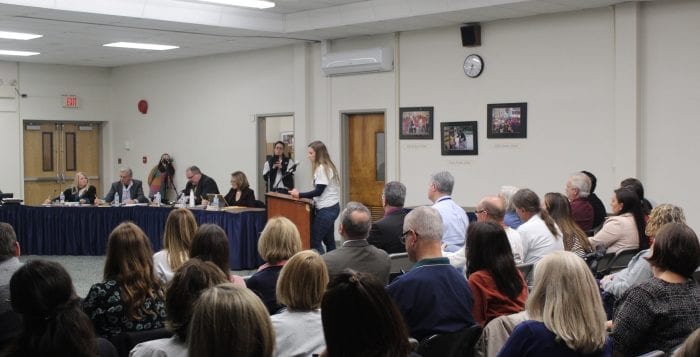
A day that began with over 60 parents and children participating in a “sickout” protest in front of Northport Middle School ended with a public meeting later that night, where the seven-member board of education unanimously voted to begin soil testing at the school.

A crowd of concerned parents and community members packed into the standing room only public meeting at the William Brosnan School. Many parents voiced dissatisfaction about how the school district has been handling recent incidents with foul odors at the middle school, saying that soil and groundwater testing are long overdue.
Many people blamed illnesses, such as cancer, headaches, nosebleeds, mold infections and other serious diseases, on the school’s long history of air quality issues.
Board President David Badanes and Superintendent Robert Banzer both reiterated to the crowd that according to experts, the middle school is safe for operations.
“Since 2017, we have made major capital and personnel improvements to the school and have corrected issues found in a 65-year-old building, as well conducted environmental testing and engaged experts from the Department of Health, the Occupational and Environmental Medicine Center of Long Island and the Icahn School of Medicine,” Banzer said. “In their professional assessments, all have indicated that the middle school is safe for occupancy. Without the assurances of these professionals we would have not occupied the school.”
“In their professional assessments, all have indicated that the middle school is safe for occupancy. Without the assurances of these professionals we would have not occupied the school.”
– Robert Banzer
The district expects that soil testing and the creation of a subcommittee will quell any remaining concerns and help bring a divided community back together.
The subcommittee will be made up of 10 members, which will include board trustees, parents, district staff and professional experts. Together they will work on an analysis and come up with parameters of the soil testing.
The timetable for the subcommittee’s actions has already been established. On Dec. 12, recommendations will be given to the board identifying experts that will conduct soil testing and additional analysis. December through January, soil testing begins. January-February, assessment of soil testing results. By March, the district expects a final report, which will include recommendations given to the board.
Parent Lauren Handler called on the board to stop utilizing the services of Hauppauge-based firm J.C. Broderick, which has come under scrutiny for some of its previous reports and findings at the middle school.
She also asked for a comprehensive review of all previous testing done at the school, additional groundwater testing, cesspool testing, and investigating the environmental impact of the VA Hospital and Covanta among other things.
“If any part of this testing cannot be completed, or if testing is completed and the source of the result cannot be identified and remediated, than this building should be closed,” Handler said. “If this request cannot be met, I’m asking the superintendent and board members to step down.”
A number of speakers called on the board to consider appointing an independent broker to select the consultant and experts that will be on the committee.
Tammie Topel, a former board member who served for six years, said she previously brought up health concerns to the board.
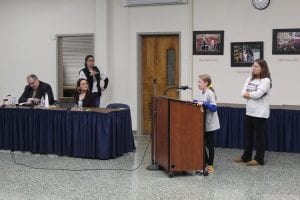
“I am a former board member and when I was on the board two years ago, I requested for soil testing more than once,” she said. “Especially during one of my final board meetings, when I learned two former students had developed aplastic anemia.”
Topel, a nurse by profession, said proposals to approve soil testing at the middle school were voted down twice during her tenure.
“Why didn’t we do this two years ago?” she asked.
A number of parents also accused the board of not being up front with information about student illnesses at the school.
“I’m alarmed and disgusted by some of these things I just learned recently,” Michael Figeroura, an emergency medical technician for the New York City Fire Department and parent, said. “I find it disgusting when kids are complaining that they have headaches or smelling metallic things, they go to the nurse and all that gets done is that they check their temperature.” In addition, Figeroura criticized Timothy Hoss, Northport Middle School Principal, for his handling of the situation.
“Who tells them [the students] after he comes into the room that there’s nothing there … But miraculously 30 minutes later there’s an email, a text message and a phone call — that yes there was some type of smell in the air and that they are working on the ventilation systems,” he said. “I want something to be done, we absolutely need more testing now and later.”
He also called for better trained medical staff in the schools.
“For a nurse to check the temperature of a child after they complained about metallic smells, it is unacceptable,” Figeroura said.
Timothy Heck, an accountant and community member, was one of a number of individuals that proposed the idea of moving the middle school students to another building in the district, arguing that the district has the available space due to declining enrollment.
“I did a rough estimate myself and I figured from the administrative and operation costs, it costs around $2.5 to $5 million to keep one of the schools open,” he said. “What makes sense to me is that you could close one of the schools down and move the kids to this building or one of the grade schools.”
Heck cited a 2015 demographic study done by the district, where they projected that about 502 students were expected to be enrolled in the middle school in 2024 compared to 2007 when it had a peak of 908 students.
Similarly, at a board of education budget meeting in January, the district projected that the schools have lost nearly 1,165 students since the 2011-12 school year.
It’s unclear if board members are considering that option.
Three board of education trustees have been appointed to the committee: Vicky Buscareno, Larry Licopoli and Tom Loughran. If you are interested in being considered for the subcommittee please send an email to: [email protected].
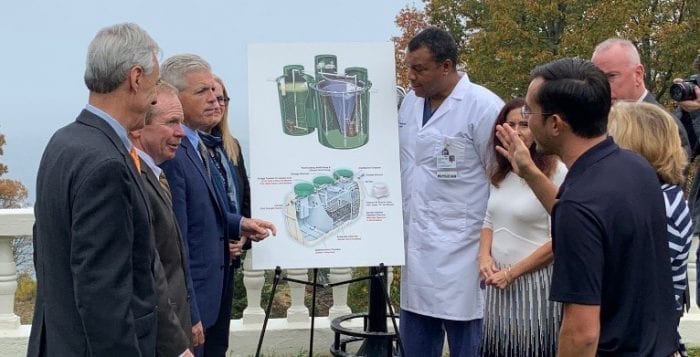
Suffolk County Vanderbilt Museum has installed two innovative systems for processing wastewater that significantly reduce the harmful impact of nitrogen pollution in the Northport Bay. The new technology builds on the county’s efforts to address excess nitrogen from wastewater leaching into local waters, which once the epicenter of the region’s red tide.
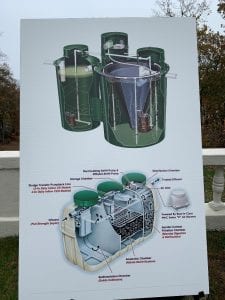
County Executive Steve Bellone (D) and county Legislator William “Doc” Spencer (D-Centerport) announced the installations at an Oct. 30 press event at the museum.
“The science is clear and the solution has been established,” Bellone said.
He noted that it is necessary to replace outdated technologies that do not reduce nitrogen pollution with new technologies that do.
“We have a $6.1 billion tourism economy that is underpinned by water,” Bellone added. “With strong support from academia, business leaders and the environmental community, our region is no longer kicking the can down the road, but is taking aggressive action to reverse the water quality crisis to better protect our waterways for future generations.”
More than 115,000 people visit the park each year and the upgrade will benefit local waterways by reducing nitrogen discharge at the site by approximately 164 pounds annually.
To date, the county has installed advanced wastewater treatment systems at Lake Ronkonkoma and Meschutt Beach, and is currently in the process of installing 13 additional systems at other parks.
The major contributor to water quality issues, Spencer said, is nitrogen discharges from more than 360,000 antiquated cesspools in Suffolk.
“I am so pleased to see this technology brought to our county parks, specifically the Vanderbilt Museum, which sits directly beside a water body that we have worked so hard to restore,” Spencer added. He said upgrades to Northport’s sewage treatment plant resulted in a massive reduction in nitrogen discharge, and produced tangible benefits including the absence of red tide and the reopening of a permanently closed Centerport beach.
The investment at Vanderbilt is expected to progress, improve and protect the region’s natural resources, Spencer added.
Officials also announced at the press event that during the month of October alone, more than 100 residents have applied for grants through the county’s septic improvement program, and that next year the county plans to install 1,200 nitrogen-reducing wastewater treatment systems, doubling the amount currently installed.
Adrienne Esposito, executive director of Citizens Campaign for the Environment, applauded the progress and collaborative efforts of everyone involved.
“This is what change looks like, one installation at a time,” she said. “Good science, good advocacy and good elected officials give us good policy, and fortunately that’s what we have seen on the water quality issue in Suffolk County.”
The installation of the new systems is part of the county’s Reclaim Our Water initiative, which seeks to reduce nitrogen pollution of surface and groundwaters.
Homeowners outside of a sewer district are encouraged to apply for grant funding and low interest loans to assist in paying to upgrade to an innovative system. Visit www.reclaimourwater.info to find out more.
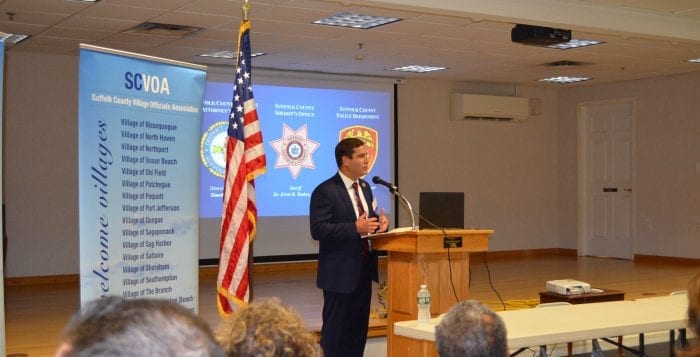
Suffolk County Village Officials Association, which represents 32 villages, hosted a special presentation on the opioid crisis Sept. 26 at the Lake Grove Village Hall.
District Attorney Tim Sini (D), Suffolk Police Commissioner Geraldine Hart and Sheriff Errol Toulon Jr. (D) all spoke to the group about how the crisis has fueled a regional surge in illegal firearms seizures and sex trafficking crimes.
Most criminal cases in the county, the officials said, relate to opioid epidemic.
People initially became addicted to prescription painkillers and over time, as demand increased, supply went down, and prices went up. So, people gravitated toward heroin, the DA said, which is more potent and more dangerous. Drug dealers, who realized that money can be made, began cutting their product with the synthetic opioid fentanyl, and more recently with fentanyl variations known as analogs. Fentanyl, Sini said, originates in China and is coming into the United States through the Mexican border. The drug is also being sent into the U.S. over the Canadian border and from China through the U.S. mail.
County officials said they are drilling down as hard as possible.
Since 2016, the federal government assigned an analyst exclusively to Suffolk County Police Department to examine overdose information with maps and weekly and monthly overdose reports. The mapping system, known as High Intensity Drug Trafficking Areas program, or HIDTA, provides a real-time picture of overdoses. It also helps identify and coordinate candidates for the county’s preventing incarceration via opportunities for treatment program known as PIVOT for short.
“Everything we do is driven by analytics,” Hart said.
The county has also been using court-sanctioned surveillance methods such as phone tapping and search warrants to crack down on drug crimes. It issued more than 350 narcotics search warrants in 2018 and has eavesdropped on more than 150 phone lines. Consequently, the county has seized greater amounts of certain drugs and illegal firearms.
The officials said during their presentation that it’s targeting dealers who cause overdoses and charging them with manslaughter. Sini said that through surveillance, he’s learning that tougher manslaughter statutes result in dealers turning away from deadly drugs to instead
peddle nonlethal drugs.
In 2018, the county also launched a sex trafficking unit that has identified and interviewed more than 200 sex trafficking victims. It has arrested 34 people for 235 counts of sex-trafficking related charges and learned during the interviews how drug traffickers use opioids to addict young women to keep them dependent.
Toulon said that they’re gathering information while the women are in the sheriff’s facility, which is providing other useful information on drug and sex traffickers.
Victims, while in the sheriff’s facility, are involved in vocational and educational programs and put in touch with nongovernmental organizations that assist with counseling, drug treatment and job training. A big problem, though, Toulon said, is housing.
County officials emphasized that human trafficking is happening right here, right now in our communities. It can affect anyone from your neighbor to your niece and nephew.
Officials are also calling for the use of different terminology for prostitution.
“It’s a modern-day form of slavery and needs to be called what it is: sex trafficking,” Hart said. The force has historically arrested the women and that was the case, Hart said, but the county’s approach is shifting and officials are now looking at the women as victims.
Officials are asking people to trust their own instincts.
“If you’re at a 7-Eleven and you see an older man in a car with a young woman who looks distressed, call or text us,” the officials said.
The county initiated a Text-a-Tip program. To reach officials, text TIP SUFFOLK to the number 888-777. Residents can confidentially share any information related to illicit or suspicious activity, including drug use or trafficking, Toulon said.
Paul Tonna, who serves as executive director of the village organization, said in a telephone interview after the event that a group of mayors were previously given a private presentation on the topic in graphic detail. The situation, he said, is horrible. The women are being forced to perform six or seven sex acts a day. He is calling for people such as PTAs and religious groups to sponsor awareness campaigns with officials.
Local villages have resources, Tonna said, such as constabulary that can also become the eyes and ears of county officials.
“We’re not here to say you need to do more,” Sini said. ”We need to think outside of the box. Because of collective efforts, we can make greater strides.”
Ann Marie Csorny is director of Suffolk County Department of Health Services’ Community Mental Hygiene Services. The Prevention Resource Center, run by the Family Service League, she said, offers effective tools for those working to prevent drug and alcohol abuse. Villages and towns, she said, should tap into coalitions that exist or start to build their own coalitions.
“Communities can have a great impact in terms of preventing or reducing drug use, alcohol abuse and related problems when they understand and promote coalition building,” she said. “This can be very exciting in that involved communities promote civic engagement and the building of shared understanding, shared norms, shared values, trust, and cooperation.”

Cow Harbor Day is an annual, weekend-long festival that celebrates the history of the Village of Northport, which was once known as Great Cow Harbor. This year, the village turns 125 years old. As the legend goes, Great Cow Harbor got its name because many cows once grazed the fields along the water’s edge. The only bovines in sight the weekend of Sept. 21 were costumed residents and festival-goers.
The tradition coincides with the end of summer and typically attracts tens of thousands of people. This year’s glorious weather, if a little warm, seemed apropos for a farewell to the season. The events included a nationally ranked 10K run, a 2K fun run, a parade with marching bands and fire trucks, carnival rides, sidewalk sales, street vendors, live concerts in the bandstand and more. After Saturday’s race, the harbor glowed at dusk and into the evening with boats illuminated and decorated for the festival.
The Town of Huntington presented closing arguments July 30 in LIPA’s tax certiorari case, but the post-trial proceedings are expected to continue into early 2020.
“Even as trial comes to an end, LIPA continues to offer the Town of Huntington the fair settlement accepted by the Town of Brookhaven last year,” LIPA spokesman Michael Deering said in an email. “The offer keeps school tax rates low for the Northport community while lowering energy costs for LIPA’s 1.1 million customers.”
Huntington Town Attorney Nick Ciappetta said in a telephone interview after leaving the Riverhead courtroom that the town had a good day in court.
“LIPA has the burden of proof,” he said. “I think we did a good job showing that their valuation estimates are unjustifiable and off base.”
Unlike jury trials that render a decision after closing arguments, the LIPA case is a bench trial. Decisions are rendered by a judge after post-trial deliberations.
Both LIPA and the Town of Huntington are expected to continue to file post-trial briefs to state Supreme Court Justice Elizabeth Hazlitt Emerson, which can take months, Ciappetta said. After that phase concludes, the judge can also take months to render a verdict.
LIPA states that National Grid’s taxes, which are passed along to Long Island ratepayers, should be 90 percent less than the $84 million that it currently pays to the Town of Huntington for the Northport power plant. LIPA estimates the plant’s tax valuation at $200 to $500 million, while Huntington’s assessed value on the tax code for the site is $3.4 billion.
“I think we did a good job showing that their valuation estimates are unjustifiable and off base.”
— Nick Chiappetta
As a general rule, the presumption is that the town’s tax assessment is accurate, according to the town’s outside attorney Patrick Seely, as stated in the July 30 court transcript.
LIPA’s public campaign on the Northport plant’s assessment relies largely on
comparisons.
“The trial is proceeding as expected, demonstrating that the aging Northport power plant is the highest taxed property in America, more than Disneyland and the Empire State Building combined and is significantly overassessed,” Deering said.
The Disneyland comparison, Ciappetta said, is comparing apples to oranges, since school taxation is calculated differently in different places.
The case was originally filed in 2011 and the trial pertains only to 2014. Each other year from 2011 to the present is heard separately, Ciappetta said.
If the town loses, it could owe hundreds of millions in tax refunds to LIPA and
National Grid.
LIPA’s legal expenses to challenge the taxes on the Northport plant have cost, from December 2018 to June 2019, a total of $1.2 million.
The Town of Huntington has so far paid more than $3.4 million, mainly in legal fees, defending the tax certiorari cases and pursuing a third-party beneficiary case against National Grid and LIPA, as reported by town Supervisor Chad Lupinacci (R) in April.
National Grid is a for-profit, shareholder-owned entity based in the United Kingdom. LIPA is a nonprofit state entity.
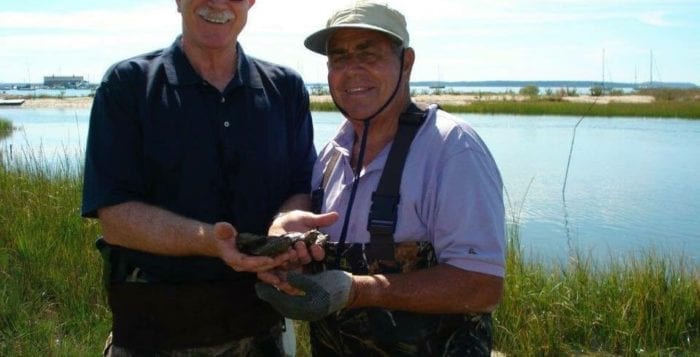
Local businessman and Village of Northport trustee Tom Kehoe has been appointed an adviser to the Trump administration on international trade in the seafood industry.
U.S. Department of Agriculture Secretary Sonny Perdue appointed Kehoe to serve on the USDA’s Agricultural Technical Advisory Committee for Trade in Animals and Animal Products. The group consists of 140 private-sector members, who will offer input on negotiating and enforcing new and existing trade agreements. Kehoe is the only individual representing the seafood industry.
Kehoe said that he is honored and humbled that the Department of Agriculture has selected him to serve.
“The sustainability and success of the seafood and agriculture industries is vital to the health and safety of all Americans,” Kehoe said. “I look forward to sharing my expertise in international trade and insight on where American trade policy needs to go in order for American businesses to thrive in international markets.”
Congress established the advisory committee system in 1974 to ensure that U.S. agricultural trade policy objectives reflect U.S. public- and private-sector commercial and economic interests. Perdue and the Office of the U.S. Trade Representative Robert Lighthizer jointly manage the committee.
Kehoe, a native New Yorker, initially got into the seafood business in 1975 in Maine with lobsters. He worked on a daily basis from 1975 to 2017 with fish and fishermen, but now deals largely with importing and exporting seafood. In 1992, Kehoe and business partner Roger Boccio opened K & B Seafood, an East Northport fish market. In 2008, they established Seaflight Logistics, a fish wholesaler that transported food both nationally and internationally. The fishmongers expanded their operation after attending an international fish market and finding a growing market for oysters and shellfish in China and Moscow. Kehoe is currently the CEO of Kingsbridge Strategies Inc., an import/export firm experienced in public policy and business consulting. The international seafood trade remains an important aspect of his operation.
“Working with small businesses, large businesses, and eventually growing my own company into an international business, I have a unique understanding of the needs of Long Island and New York’s businesses — as well as businesses nationwide who rely on international trade — and I look forward to representing these interests on this committee,” Kehoe said.
One of Kehoe’s biggest customers for 25 years has been the Grand Central Oyster Bar in Grand Central Station. Sandy Ingber is the executive chef there and part owner of the restaurant. He said that Kehoe’s appointment will help him. In the summer, Ingber said the Oyster Bar offers 20 different types of oysters and each day serves as many 4,000 oysters on the half shell.
“Tom is an honest man and knowledgeable about the seafood industry,” he said. “I’m excited about getting European oysters here in America.”
Kehoe is also a representative on the U.S. Department of Commerce, New York District Export Council. He formerly served as the president, vice president and director of the East Coast Shellfish Growers Association. Kehoe is a former Northport police commissioner and deputy mayor. Kehoe currently serves as the village’s commissioner of commerce, his third stint at the post. Kehoe’s term with the USDA will expire in 2023.
Northport trustee Tom Kehoe has stepped down from his appointed position as deputy mayor of Northport but will remain in his elected position of trustee. Kehoe began construction on his Northport home, he said, before receiving proper permits. In consultation with the mayor, it was decided to be the best option, since the situation was too much of a distraction.
Kehoe’s home has been boarded up and vacant since it burned down in May 2017. After the town granted permission to demolish the structure, which was in December 2018, Kehoe said that he poured a new foundation in January and started framing the house in March.
“Shame on me,” Kehoe said. “I’m taking responsibility, I’m taking my medicine.” He is waiting now for the proper authorizations before continuing with the work, he said, and his paperwork has been filed with the building department.
Kehoe attributes the delay in authorizing the demolition of his home to a conflict with the village’s architectural review and preservation board. He said that he had to prove that his home was neither historical nor architecturally significant.
Kehoe has served as a Northport trustee since 2006 and was most recently re-elected in 2018.
“I have two years and 11 months to fulfill my term,” Kehoe said. He said that he expects to continue to serve village residents.
Kehoe said that he will need to meet with the zoning board to address issues related to removing a side entrance and correcting an 18-inch error in footing positions.
